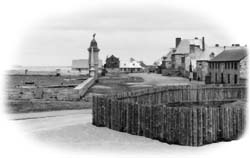



    |
|
|
Louisbourg Connection In spite of numerous voyages to Cape Breton by intelligent and enterprising navigators in the late 16th and early 17th centuries, the first mention of the existence of coal seams, which were plainly visible in the cliffs of many bays and headlands, is found in the Description and Natural History of the Coasts of North America by Nicholas Denys, published in Paris in 1672. In 1654, Denys had obtained a concession from Louis XIV for the mineral rights to the whole island, paying the King 1/10 of any profit. In the preface to his book, Denys wrote: "There are mines of coal through the whole extent of my concession, near the sea coast, of a quality equal to the Scotch, which I have proved at various times on the spot and also in France, where I brought them for trial." He continued, "At Baie des Espagnols [Sydney] there is a mountain of very good coal, four leagues up the river" and "another near the little entrance of the Bras d'Or Lakes." After his departure in 1672, unauthorized persons helped themselves to whatever coal they needed. This was rectified in 1677 by an ordinance issued by M. Duchesnau, the Intendant of New France, establishing Denys' right to exact a tax of 20 sous per ton from all persons taking coal from Isle Royale. This patent was revoked in 1690. In addition to developing the French fishing trade, designs were made to use the coal from Sydney Harbour for the refining of sugar in the West Indies, and a report in 1687 states that coal was taken from Isle Royale to France and used in the royal forges.  In 1708, a memoir to the French Government by Raudot, Intendant of Finance, recommended that a port be chosen in Isle Royale so that "the island could furnish Old France with coal, codfish (etc.)..."
In 1708, a memoir to the French Government by Raudot, Intendant of Finance, recommended that a port be chosen in Isle Royale so that "the island could furnish Old France with coal, codfish (etc.)..."
Both the French and English were visiting these shores and in one instance, in 1711, Admiral Hovenden Walker, commanding a British Naval Squadron, sailed into Spanish Bay, now Sydney. Walker wrote in his journal, "The island had always, in times of peace, been used in common both by the English and the French for loading coals, which are extraordinarily good here and taken out of the cliff with iron crow bars only, and no other labor." Under the Treaty of Utrecht (1713), the French were left only with Isle Royale on the east coast of Canada. The French government decided to build a Fortress here to protect the rich fishing grounds and to serve as a fortified entrance to the Gulf of St. Lawrence. Besides firewood, coal was required for fuel in the construction of the fortress, a ready source of which was found locally. In order to encourage the development of the infant coal industry, the French Naval Board, in charge of overseas colonies, remitted the duties on coal coming from Isle Royale (C.B.I.) in January 1715. This lasted until 1726. Later, fishing boats were encouraged to use coal as ballast when returning to France. The first attempt to mine coal, in a regular fashion, was made on the seam found on the north side of Cow Bay (Morien) in 1720. Fuel was urgently needed for the host of officers, soldiers and tradesmen involved with the construction of Louisbourg. NEXT PAGE |
|
The History |
The Future
Regional Impact | Mining Techniques | The Museum Main | Glossary | Site Map | Text Only |

Created by Virtual Media Productions Ltd., © 1997.
|